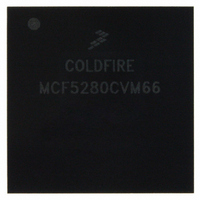MCF5280CVM66 Freescale Semiconductor, MCF5280CVM66 Datasheet - Page 621

MCF5280CVM66
Manufacturer Part Number
MCF5280CVM66
Description
IC MPU 32BIT COLDF 256-MAPBGA
Manufacturer
Freescale Semiconductor
Series
MCF528xr
Datasheet
1.MCF5216CVM66J.pdf
(766 pages)
Specifications of MCF5280CVM66
Core Processor
Coldfire V2
Core Size
32-Bit
Speed
66MHz
Connectivity
CAN, EBI/EMI, Ethernet, I²C, SPI, UART/USART
Peripherals
DMA, LVD, POR, PWM, WDT
Number Of I /o
142
Program Memory Type
ROMless
Ram Size
64K x 8
Voltage - Supply (vcc/vdd)
2.7 V ~ 3.6 V
Data Converters
A/D 8x10b
Oscillator Type
External
Operating Temperature
-40°C ~ 85°C
Package / Case
256-MAPBGA
Controller Family/series
ColdFire
No. Of I/o's
150
Program Memory Size
2KB
Ram Memory Size
64KB
Cpu Speed
66.67MHz
Embedded Interface Type
CAN, I2C, SPI, UART
No. Of Pwm Channels
8
Rohs Compliant
Yes
Lead Free Status / RoHS Status
Lead free / RoHS Compliant
Eeprom Size
-
Program Memory Size
-
Available stocks
Company
Part Number
Manufacturer
Quantity
Price
Company:
Part Number:
MCF5280CVM66
Manufacturer:
FREESCAL
Quantity:
151
Company:
Part Number:
MCF5280CVM66
Manufacturer:
Freescale Semiconductor
Quantity:
10 000
Company:
Part Number:
MCF5280CVM66J
Manufacturer:
Freescale Semiconductor
Quantity:
10 000
Company:
Part Number:
MCF5280CVM66L
Manufacturer:
FREESCAL
Quantity:
151
- Current page: 621 of 766
- Download datasheet (9Mb)
branch target address calculation is based on the contents of a program-visible register (variant
addressing). DDATA outputs can be configured to display the target address of such instructions in
sequential nibble increments across multiple processor clock cycles, as described in
“Begin Execution of Taken Branch (PST =
connecting the processor’s high-speed local bus to the external development system through PST[3:0] and
DDATA[3:0]. The buffer captures branch target addresses and certain data values for eventual display on
the DDATA port, one nibble at a time starting with the least significant bit (lsb).
Execution speed is affected only when both storage elements contain valid data to be dumped to the
DDATA port. The core stalls until one FIFO entry is available.
Table 30-2
Freescale Semiconductor
0x8–
Hex
0xC
0xD
0xB
0x0
0x1
0x2
0x3
0x4
0x5
0x6
0x7
PST[3:0]
Binary
1000–
0000
0001
0010
0011
0100
0101
0110
0111
1011
1100
1101
shows the encoding of these signals.
Continue execution. Many instructions execute in one processor cycle. If an instruction requires more
processor clock cycles, subsequent clock cycles are indicated by driving PST outputs with this encoding.
Begin execution of one instruction. For most instructions, this encoding signals the first processor clock
cycle of an instruction’s execution. Certain change-of-flow opcodes, plus the PULSE and WDDATA
instructions, generate different encodings.
Reserved
Entry into user-mode. Signaled after execution of the instruction that caused the ColdFire processor to
enter user mode.
Begin execution of PULSE and WDDATA instructions. PULSE defines logic analyzer triggers for debug
and/or performance analysis. WDDATA lets the core write any operand (byte, word, or longword) directly
to the DDATA port, independent of debug module configuration. When WDDATA is executed, a value of
0x4 is signaled on the PST port, followed by the appropriate marker, and then the data transfer on the
DDATA port. Transfer length depends on the WDDATA operand size.
Begin execution of taken branch. For some opcodes, a branch target address may be displayed on
DDATA depending on the CSR settings. CSR also controls the number of address bytes displayed,
indicated by the PST marker value preceding the DDATA nibble that begins the data output. See
Section 30.3.1, “Begin Execution of Taken Branch (PST =
Reserved
Begin execution of return from exception (RTE) instruction.
Indicates the number of bytes to be displayed on the DDATA port on subsequent processor clock cycles.
The value is driven onto the PST port one CLKOUT cycle before the data is displayed on DDATA.
0x8 Begin 1-byte transfer on DDATA.
0x9 Begin 2-byte transfer on DDATA.
0xA Begin 3-byte transfer on DDATA.
0xB Begin 4-byte transfer on DDATA.
Exception processing. Exceptions that enter emulation mode (debug interrupt or optionally trace)
generate a different encoding, as described below. Because the 0xC encoding defines a multiple-cycle
mode, PST outputs are driven with 0xC until exception processing completes.
Entry into emulator mode. Displayed during emulation mode (debug interrupt or optionally trace).
Because this encoding defines a multiple-cycle mode, PST outputs are driven with 0xD until exception
processing completes.
MCF5282 and MCF5216 ColdFire Microcontroller User’s Manual, Rev. 3
Table 30-2. Processor Status Encoding
0x5).” Two 32-bit storage elements form a FIFO buffer
Definition
0x5).”
Section 30.3.1,
Debug Support
30-3
Related parts for MCF5280CVM66
Image
Part Number
Description
Manufacturer
Datasheet
Request
R
Part Number:
Description:
Manufacturer:
Freescale Semiconductor, Inc
Datasheet:
Part Number:
Description:
Manufacturer:
Freescale Semiconductor, Inc
Datasheet:
Part Number:
Description:
Manufacturer:
Freescale Semiconductor, Inc
Datasheet:
Part Number:
Description:
Manufacturer:
Freescale Semiconductor, Inc
Datasheet:
Part Number:
Description:
Manufacturer:
Freescale Semiconductor, Inc
Datasheet:
Part Number:
Description:
Manufacturer:
Freescale Semiconductor, Inc
Datasheet:
Part Number:
Description:
Manufacturer:
Freescale Semiconductor, Inc
Datasheet:
Part Number:
Description:
Manufacturer:
Freescale Semiconductor, Inc
Datasheet:
Part Number:
Description:
Manufacturer:
Freescale Semiconductor, Inc
Datasheet:
Part Number:
Description:
Manufacturer:
Freescale Semiconductor, Inc
Datasheet:
Part Number:
Description:
Manufacturer:
Freescale Semiconductor, Inc
Datasheet:
Part Number:
Description:
Manufacturer:
Freescale Semiconductor, Inc
Datasheet:
Part Number:
Description:
Manufacturer:
Freescale Semiconductor, Inc
Datasheet:
Part Number:
Description:
Manufacturer:
Freescale Semiconductor, Inc
Datasheet:
Part Number:
Description:
Manufacturer:
Freescale Semiconductor, Inc
Datasheet:











